 |
|
|
Spiritual Humanism
A Formula that Works
By Pravrajika Gayatriprana, MD, Ph.D. (USA)
Introduction
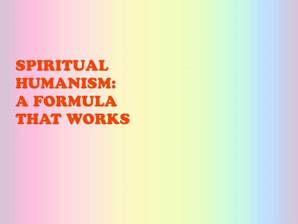
The title of this talk is Spiritual Humanism: A Formula That Works. Spiritual Humanism is a term I arrived at to describe an important aspect of the work of Swami Vivekananda (1863-1902) in both the West and in India. It relates to his conviction of the supreme importance of the human individual, not just as a unique, physically embodied being, but also on account of the capacity to evolve and express in full the divinity innate in every one of us. I see this as an integration of the Western notion of humanism (to which he was exposed as a student and which he felt was so very unavoidable and necessary in contemporary times) and the Indian ideal of selftransformation through yoga to the excellent human being, the ideal, the real, or Brahman, which was innate in his Indian soul.
I have been able to trace this vision to his experiences with Sri Ramakrishna (1836-1886) and also to how he implemented the various stages of its unfoldment in his life during his period of public work:

In this talk I shall give glimpses into how Sri Ramakrishna conveyed to Vivekananda the insights he later carried worldwide and how Vivekananda shared them with India and the West. In addition, I shall connect this “interior” work with what actually happened in the “exterior” world, so that we can deduce what might have been the connections between the two.
First Step of Spiritual Humanism:
Vivekananda meets Sri Ramakrishna and Later Introduces Spiritual Humanism
On first meeting with Sri Ramakrishna in February-March of 1882, Vivekananda was full of Western notions of humanism, science, and democracy and challenged Sri Ramakrishna directly, suggesting that, as an "ignorant shaman", Sri Ramakrishna was hopelessly out of touch with reality. Sri Ramakrishna's response was to precipitate Vivekananda into a profound samadhi or superconscious state, from which Vivekananda emerged with the insight that 1:

This was such a shock to Vivekananda’s Western rationalism and notions of the extent of human consciousness that he could not respond to it on his own. Sri Ramakrishna himself made it clear how this worked in actual fact. Speaking about the practical difficulties inherent in dealing with many of our worldly situations, he told Vivekananda in March, 1882:
“God dwells in all beings. But you may be intimate only with good people; you must keep away from the evil-minded. God is even in the tiger, but you cannot embrace the tiger on that account.”

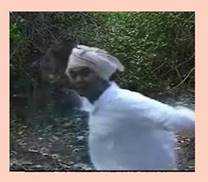
“You may say, ‘Why run away from the tiger, which is also a manifestation of God?’ The answer to that is2:
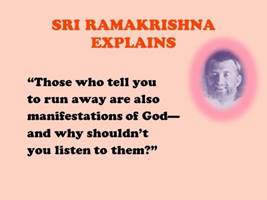
This was practical common sense, emphasizing the very humanistic values of ethical living and of respecting and appreciating our relationships with our colleagues and friends--those who know and value us in and of ourselves, and not in order to gain control or influence over us.
These two experiences convinced Vivekananda of the truth of the Indian emphasis on the possibility of deep meaning in the depths of human consciousness—
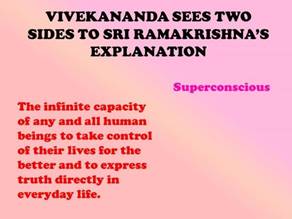
what he called the superconscious—combined with the Western belief in the infinite capacity of any and all human beings to take control of their lives for the better.
In his later teaching work he took up the view that in the West—then the technological masters of the world, but trapped almost to suffocation in their own materialistic humanism—the emphasis was to be on the spiritual dimension of humanity and on yoga, the time-tested methods of spiritual self-transformation, though stripped of sectarian and caste restrictions and so on, and thereby democratized so that it could be assimilated in the West. For him, India, saturated with a long tradition of spiritual self-transformation, now had to become proactive in finding ways to express that spirituality in terms of human concern and well-being.
Some ten years later the validity of Vivekananda’s views was demonstrated, first in Chicago at the Parliament of Religions, where he expanded the prevailing notion of the human being from the individual identified primarily with the body and matterbased mind into “infinite, universal individuality.”3
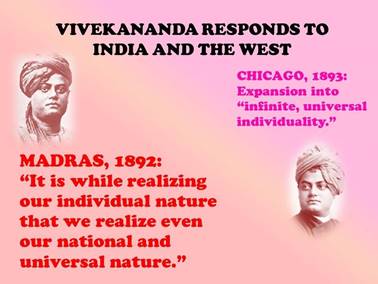
He made it clear that “to gain this . . . individuality, this miserable little prison individuality must go” (Ibid.).
In India Vivekananda started small, with a devoted group of young men in Madras. With them Vivekananda focused on the heartless treatment and degradation of the lower castes by the traditional spiritual aristocracy adding, “at the same time preaching wonderful Adwaitism [inherent human divinity]—is it not adding insult to injury?”4 He went on to delineate the value of the individual to the whole, using the metaphor of the human body: “Each cell has its part in bringing about consciousness. Man is individual and at the same time universal.
It is while realizing our individual nature that we realize even our national and universal nature” (Ibid., p.121).
Here was a new approach to the traditional Indian view of righteousness and yoga: the importance of the human individual, not only in building up his or her life spiritually, but also to making a significant contribution to the whole of humanity and its wellbeing.
With regard to the impact that Vivekananda had on his audiences, what we might call the spiritual antidote to Western materialism—the notion of the superconscious innate in everyone—was received with rapture by the thousands of Westerners attending the Parliament in Chicago. These Western people, attracted by an unprecedented interreligious meeting, were all, no doubt, humanists, but apparently seeking something more and could respond directly to Vivekananda’s new insights. And it seemed as if Vivekananda had generally struck the right note, because thereafter he became very well-known and received, with many offers of speaking engagements and of meeting some of the most prestigious people in the USA and England, as well as an avid following from New Thought circles that had been embracing the principles and practices of Vedanta on their own. We see in this picture Swami Vivekananda sitting at bottom left and the tall gentleman in the Trilby hat to the right is Ralph Waldo Trine, one of the earliest and most influential thinkers in the New Thought movement.
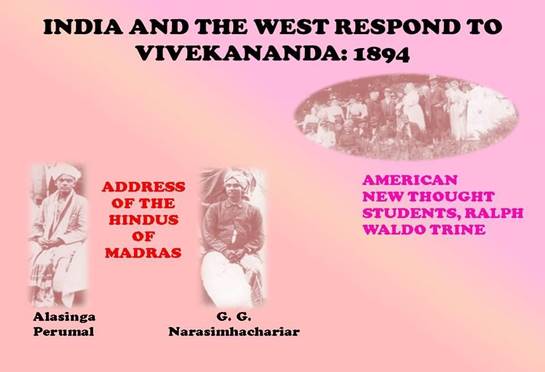
Finally, in 1894 Vivekananda was able to found the Vedanta Society of New York, the first Vedanta Society ever, which is still going strong. This is my own alma mater, where I was trained by Swami Pavitrananda.
With regard to India, Vivekananda seems to have aroused in these young men— of whom Alasinga Perumal and G. G. Narasimhachariar were prominent—the same ardor and love that he awakened in the people in Chicago, for these were to commit themselves to this ideal and to work incessantly to make it a living reality for the betterment not only of themselves, but also of India and the whole world.
One of their first, very bold actions was to respond to Vivekananda’s request for support from India. The swami was under serious attack in the West from fundamentalist Christians and his work was losing ground. The “young lions” of Madras immediately set to work and mustered all of the big names in the city as signees to the Madras Address, the arrival of which in Chicago loosed a flood of tears in Vivekananda and established his credentials beyond doubt in the West. His reply to this address is a sweeping overview of Vedanta as well as the introduction of his own vision for India.
Second Step of Spiritual Humanism:
Vivekananda Engages with Sri Ramakrishna and Later with His Own Students
This had been the opening salvo, as it were, in Vivekananda’s delivery of spiritual humanism to the world. He delivered the message and found his response in both the West and in India. But there was more to come. Going back to his own training by Sri Ramakrishna,

In this context we see Vivekananda with Sri Ramakrishna on February 18, 1883. After ecstatic dancing with Vivekananda and the devotees, Sri Ramakrishna sat down and returned to the theme of the tiger God with which he had introduced the idea of a sliding scale of divine manifestation to Vivekananda nearly a year before. Although it was the same story as before, the emphasis was rather different, suggesting that Sri Ramakrishna was trying to move Vivekananda’s understanding along. Sri Ramakrishna began,5
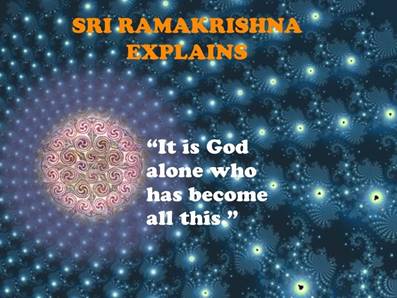
—a rather stronger statement than the “God dwells in all beings” of March, 1882 (Ibid., p.84). Again, the emphasis in March of 1882 had been on the practical necessity of keeping away from the evil-minded (Ibid.)—an injunction meant for beginners (such as Vivekananda himself) whose minds were preoccupied with empirical differences. A year later, we find that Sri Ramakrishna’s emphasis had become (Ibid., p.181):
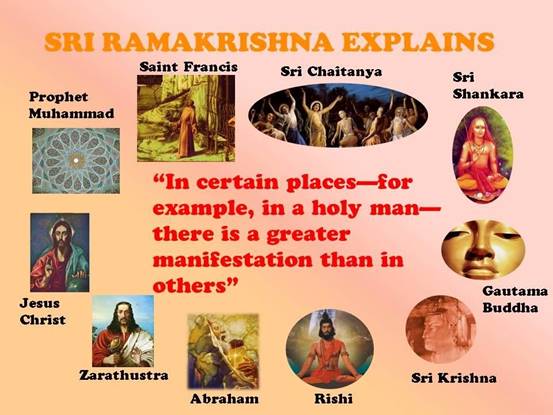
This new emphasis served, not only to underscore the concept of degrees of manifestation of human divinity,

but alsoto direct Vivekananda’s attention to the importance of spiritually developed people in setting a practical standard of evaluation.
That Vivekananda did not raise the objection of the spiritual élitism usually found in relation to great spiritual teachers in such a situation seems likely on account of Sri Ramakrishna’s frank statements about his uncompromising commitment to innate human spirituality four months previously. In short, it was as if Sri Ramakrishna were being more explicit about how human divinity is manifested and what constitutes its high-water mark. Again, of the nature of what Sri Ramakrishna meant by “holy people” Vivekananda had ample proof from studying Sri Ramakrishna himself.
We find Vivekananda expressing these ideas, first in New York in 1894, where he added to his initial emphasis on intrinsic human divinity by stressing its universality, despite apparent external variations, and also the need to bring out our divinity in a systematic way. Taking up the idea of the body—that obstacle to spiritual vision in the West especially—he said:
“The soul . . . takes to itself a body for the same reason that I take a lookingglass—to see myself. Thus, in the body, the soul is reflected. The soul is God, and every human being has a perfect divinity within himself”; and “each one must show his divinity sooner or later.”6

To India, the same year, he reiterated his intense conviction of the divinity of each and every human being without exception, taking all kinds of forms:
The truth . . . in our religion [is] the spirit of man, the Atman of man . . . whose glories the Vedas themselves cannot express, before whose majesty the universe with its galaxy upon galaxy of suns and stars and nebulae is as a drop.
“Every man and woman . . . is such a spirit involuted or evoluted. The difference is not in kind, but in degree .”7
And in private he said, “Henceforth there is an end to all sorts of distinctions, and everyone down to the chandaala [outcaste] will be a sharer in the divine love. . . . In this Satya Yoga [Age of Truth] the tidal wave of Sri Ramakrishna’s love has unified all.”8
In these thoughts and aspirations, we can see Vivekananda’s vision of a new Vedantic order based on the value of each and every human being as a manifestation of the very spirit that was the intellectual heritage of even the humblest Hindu.
The upshot of these two insights was, in the West, the formation of a group of sincere students of yoga who, in addition to their yoga practice, also worked to edit and publish Vivekananda’s classes and lectures on yoga, karma, bhakti, raja and jnana yogas.

These were published in the West and circulated there for decades, especially Raja-Yoga, which remained in circulation until as late as 1938, when the great cultures of the West were teetering on the brink of near-annihilation.
Perhaps under the impetus of such a new ideal, the Madras “boys” worked mightily to bring out the yoga texts in Indian editions, and also succeeded in getting off the ground the English-language journals The Brahmavadin and Prabuddha Bharata, to spread the Vedanta of Sri Ramakrishna and Vivekananda all over India and the world. Both journals are still with us and doing yeoman service.
The Third Step of Spiritual Humanism:
Vivekananda Embraces Sri Ramakrishna’s Source of Inspiration
The third step of Vivekananda’s training and subsequent work related to how to deal with the obstacles that arise in implementing spiritual humanism. At Dakshineshwar in 1884, 9
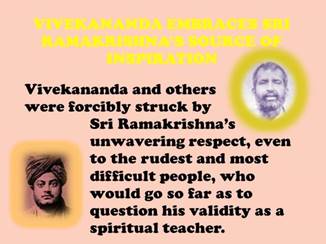
Of them,
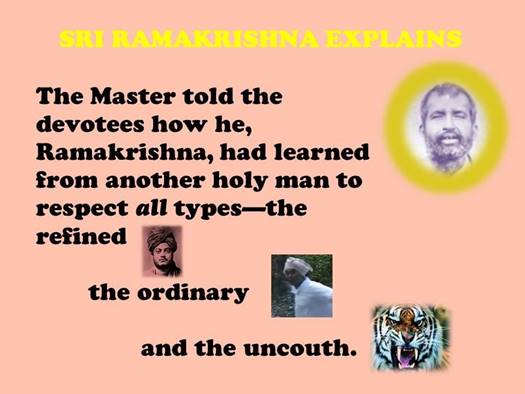
Vivekananda smiled at this and referred to Sri Ramakrishna’s story about the [tiger]: “What? Is it like the [tiger] God? All, indeed, are God” (Ibid., p.528). Sri Ramakrishna rejoined smilingly,
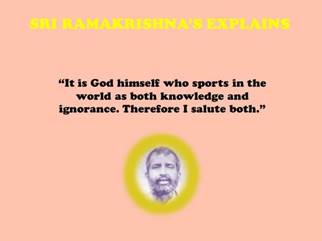
He went on:
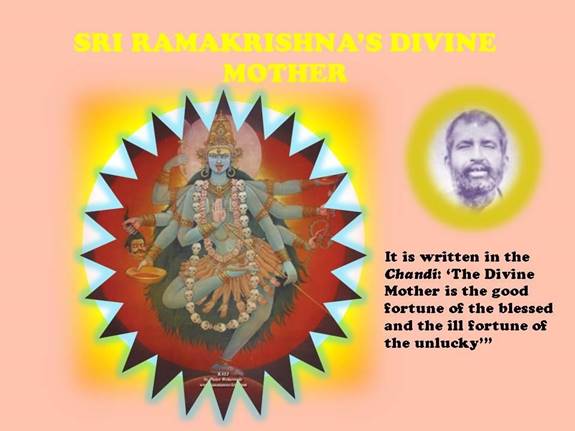
At this point he was treading on delicate ground with Vivekananda, for it was the Divine Mother above all that Vivekananda found so hard to reconcile with his imperious Westernized rationalism. It was she, however, who was the power underwriting the democratic idea of the equality of human beings as spirit. To Vivekananda,
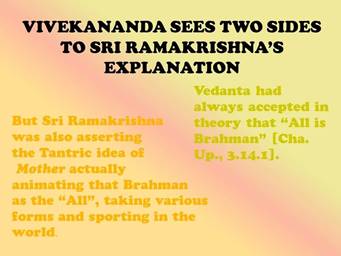
Out of his love and knowledge of Mother, Sri Ramakrishna gladly accepted all forms as hers, and treated them with respect as well as saluting them with reverence. In this way he rose above all forms of discrimination and separation, that we can think of as the root cause of maya.
In early 1896 Vivekananda shared these insights with his students. In the West during this period of his work, he addressed the issue as follows in The Vedanta Philosophy, which began a new trend of thought 10:
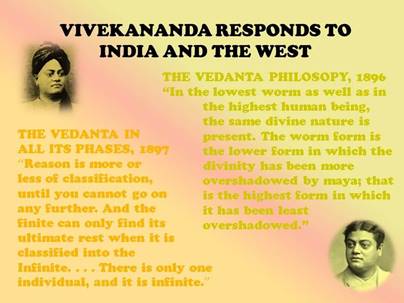
Here the mystery of maya (of how we obscure the Self—our divine nature—from manifesting) is brought out, with the implication that it is a matter of perception. In his lectures on maya in London some seven months later, Vivekananda was to enlarge upon this mystery and supply the insights as to how to change our perception in order to transfigure our understanding of the individual as Sri Ramakrishna had demonstrated in 1885.
In India in the spring of 1897, Vivekananda’s presentation 11, underscored the acute problem of Vedantins at that time: Western materialism vs. Vedantic idealism. Vivekananda solves the problem by telescoping the perception of matter and the concrete “individual” it creates into the wider context of the infinite Individual preached by the Vedanta. But this does not minimize the individual; rather, it enhances him or her, because that very Self is their real nature or individuality. In doing so, Vivekananda points to the Self as the primary power animating our lives, the goal in merging into which our finite minds will assume the pure divinity that makes us truly human.
This was the “intellectual” phase of Vivekananda’s work.
In the West, related to his friendship with the distinguished Harvard psychologist, William James, The Vedanta Philosophy was delivered to the Graduate Philosophical Society of Harvard University. Vivekananda was shortly to meet Professor Max Muller of Oxford University, who subsequently wrote the first biography of Sri Ramakrishna in the West: Ramakrishna: His Life and Sayings, and to go on to befriend: Professor Paul Deussen, the acclaimed German Vedantin and to assist him in his historic interpretation of the Vedanta, especially in his book Seven Upanishads of the Veda (1897).

In the fall of 1896 the conclusion of this phase was his magisterial lecture series on maya in London. The palpable response to this work was the publication of the lectures and the formation of a dedicated group of students, who earnestly sought to know how they could apply these ideas to their own lives.
Vivekananda delivered his Indian insights on his highly prestigious journey from Colombo to Almora, during which India rose up to honor and acclaim his work. In the picture we see Swamiji at left center, surrounded by a sea of Indian admirers. Right next to him are sitting three Western people, a sign of how significant his appearance was under the circumstances pertaining at that time.
Vivekananda went on to found the Ramakrishna Math and Mission, which would dedicate itself to propagating the ideals and implementing methods to bring it to fruition in India. In this way, his humanistic vision of Vedanta was beginning to manifest a concrete shape in India, to empower individuals in the name of the Self and to invest them with the sacredness of the divine, even in their earliest and most unregenerate stages of development and apparently humdrum or lowly work.
The Fourth Stage of Spiritual Humanism Human to Divine and Divine to Human:
Realization and Manifestation
The fourth stage of spiritual humanism began in 1886, again with Sri Ramakrishna:
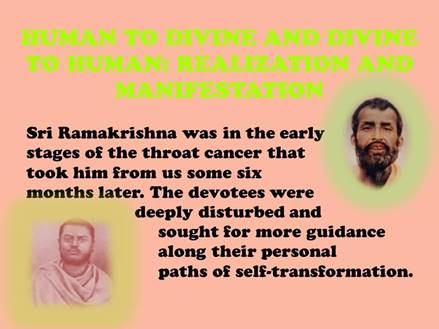
Perhaps to encourage them to press on with their own perfecting, Sri Ramakrishna told a parallel story to the tiger and the friend, this time of the elephant and its mahut, by concluding (Ibid., p.853):

In this new version of his teaching of the divine manifesting in different degrees, Sri Ramakrishna had added another dimension. This time, he had given a concrete standard by which to judge the degree of manifestation of divinity—pure Mind and pure Intelligence. For, as he gave these as attributes of God within the human heart, it follows that we may see that very God most clearly in a pure human mind and intelligence. But this, of course, was a far cry from our “ordinary” consciousness. What was the process that could connect us up to such manifest divinity? Vivekananda—who was present at these discussions—came up with the idea that:

In this way Vivekananda expressed the two sides he saw in what Sri Ramakrishna was saying:

In the West, scientistic ideas of evolution had stripped humanity of its divinity which thereby had no clear-cut goal for human evolution to attain. In London at the end of 1896, Vivekananda, enlarging, in his lectures on Practical Vedanta—another magisterial series of presentations on the theme of the Self, the divine nature present in all—pointed first to its democratic implications:
“From the standpoint of the highest ideal, the lowest animal and the highest man are the same. 12 This is because all contain the same prophet-soul; only we must know it.” (Ibid., p.308).
This is the knowledge that makes a person the highest and this is the knowledge that is needed in the West. Moreover,
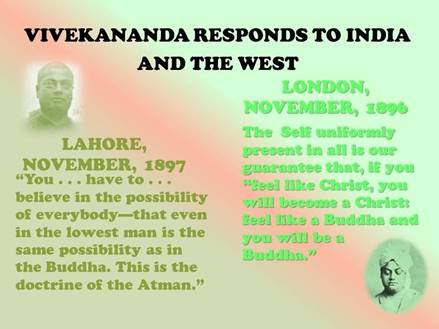
In Vivekananda’s Indian work, we find these ideas in his lecture The Vedanta, anothermajor “manifesto” given in Lahore on November 12th, 1897, where he said: “The Vedas [the canonical texts of Vedanta] . . . are the eternal laws living in every soul. The Vedas are in the soul of the ant, in the soul of the god. The ant has only to evolve and get the body of a sage or a rishi and the Vedas will come out, eternal laws expressing themselves. This is the one great idea to understand—that our power is already ours, our salvation is already within us. “You . . . have to believe in that, believe in the possibility of everybody—that even in the lowest man is the same possibility as in the Buddha. This is the doctrine of the Atman.”13
The striking validation of this work in the West was:
The publication of the lectures on Practical Vedanta and the commitment of some outstanding Western people to Vivekananda’s cause : Sister Nivedita, Mr. Josiah Goodwin and Sister Christine, who lived and worked for Vivekananda in India; and Mrs. Sarah Bull, Mr. Francis Legget, and Miss Josephine MacLeod, who steadfastly supported the Indian work financially and in a variety of ways.
In India, his tremendous reception in Lahore and his lecture The Vedanta led to the consolidation behind Vivekananda of:
His brother-disciples and the move to:
Belur Math, the permanent headquarters and central symbol of his Indian work.
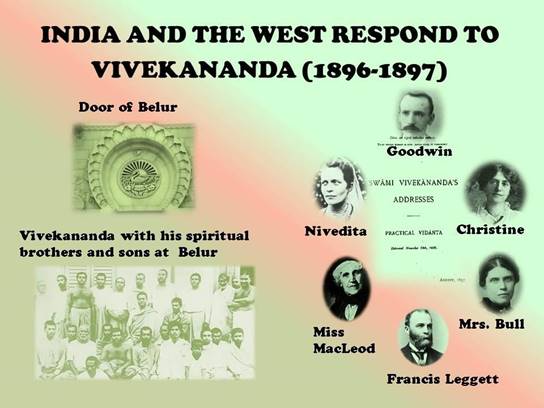
The fifth Step of Spiritual Humanism:
Vivekananda, the Integral Seer
The fifth and final development of spiritual humanism took place just before the passing of Sri Ramakrishna. At that time he was unable to speak much on account of his illness, and Vivekananda had to grasp directly what was in the Master’s mind. However,
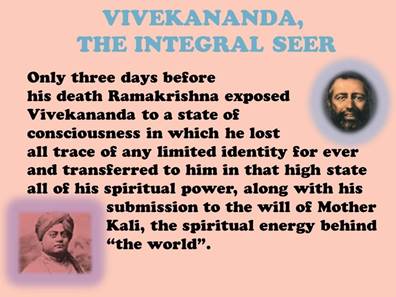
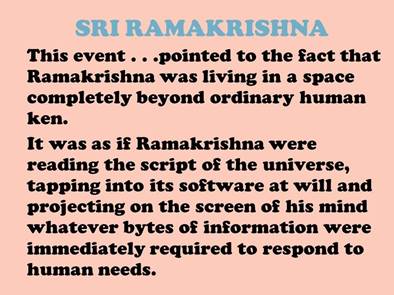
From another standpoint, Sri Ramakrishna had revealed to Vivekananda, step by step, four different ways of looking at the relationship between human and divine, and each had seemed satisfying at the time, but each had been superseded by yet another compelling integration.
And now this fact of fully integral consciousness as the last word was placed before Vivekananda.
Were those viewpoints that had gone before it untrue? In the state in which Vivekananda now was, he could see that, from the standpoint of an integral being like Sri Ramakrishna, there need be no conflict at all. Not only are each of the explanations perfectly right and true at their own particular stage, they may also be accepted as all equally true and valid in the concrete, dynamic, moment-to-moment process of living of a soul which is fully identified with the divine.
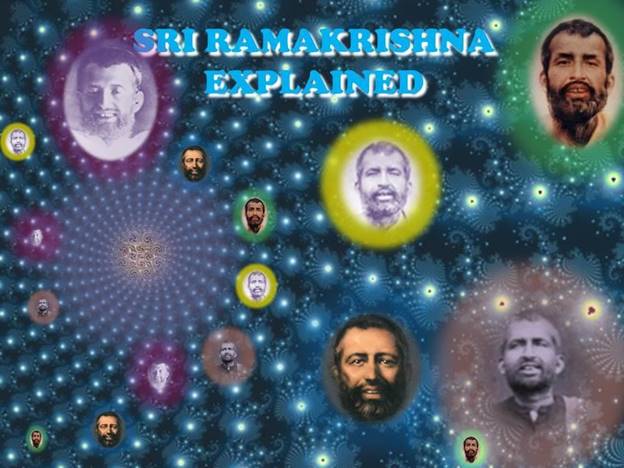
Perhaps it is this consciousness, able to integrate and harmonize and use all levels of perception in practical, daily living that is the final word on human consciousness, as far as our contemporary thinking can go. It is too early yet for humanity to grasp the magnitude of his completely integrated view of life, moving from the ordinary, concrete realities of everyday experience to the fullness of the superconscious, not according to any rule or regulation or series or explicable theory, but utterly spontaneously.
This fits into the traditional pattern of the integral seer who opens the door to divinity to those who seek it earnestly. But, lest we should object that such an option depends upon the whim or will of a specific human being who may or may not be available to us for one reason or another, Sri Ramakrishna himself and Vivekananda after him, emphasized again and again that they were 14

And that principle is inherent throughout the entire cosmos, including human minds and hearts. If we can conceive of our divine potentialities from hearing these teachings, and if we engage ourselves properly with them, they will inevitably work themselves out and bring us to whatever state of consciousness we aspire to.
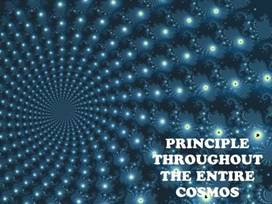
In this fifth state of consciousness accessible to humankind, the capacity to think and act from several standpoints simultaneously creates a unique effect. Although the subject of the discourse of such a person may seem mundane, even trivial, it is found on inspection to contain the entire gamut of meaning from the concrete to the transcendental, all harmoniously aligned in a sort of spiritual laser beam, and therefore carrying tremendous power to penetrate, enlighten, and transform its hearers on all levels.
In the last period of his life in the West, we find Vivekananda’s final message in Is Vedanta the Future Religion? given in San Francisco on April 18, 1900 15:

Here we find him taking up the idea of democracy, the central idea of the West, and broadening its base by focusing it on the spiritual reality of human beings. By evolving true, spiritual human beings, democracy will come to have a much more universal meaning and deeper, stronger roots. Vivekananda also spoke on My Life and Mission in Pasadena on January 27, 1900, in which he represented Sri Ramakrishna as “not going in much for intellectual scholarship, scarcely studied books; but when he was a boy he was seized with the tremendous idea of getting truth direct.” 16 This may be said to be Vivekananda’s special message to the West. In India this ideal has been known for millennia, but the West needed to know that there is a direct path between our ordinary, rationalistic consciousness and the higher consciousness that makes “reason unreason, mortal immortal, this world a zero, and of man a god.”17 The summation of his final Western teachings may be said to dignify democracy as a means of granting freedom from predetermined forms and the license to genuine experiment in the project of human evolution to the super-conscious state. In that sense, he taught the West spiritualized democracy.
In India, the final phase of Vivekananda’s public work was expressed sometime after 1899 in the only full-length statement—Hinduism and Ramakrishna—he made for India on the subject of Sri Ramakrishna. There he extols the Vedas as the “only exponent of the universal religion for all mankind on account of their emphasis on super-conscious truths”18, which he overtly contrasts with the “truth cognizable by the five ordinary senses of man, and by reasonings thereon” (Ibid.). However, though he thus distances himself from Western discursive rationalism, he also distances himself from traditional Vedic teachings based on caste, etc. and, therefore, Vedantic fundamentalism. Sri Ramakrishna is represented as the archetypal Vedic rishi, “who demonstrated, without the help [or obstacle!] of modern education, how supersensuous truth reveals itself.” (Ibid.).
Vivekananda asserts that, by thus reinstating the primacy of super-consciousness over all other forms of knowledge, Sri Ramakrishna harmonized all of the apparently diverse forms of Hinduism, energized the traditions associated with it, and launched an unprecedented renaissance of Vedantic culture (Ibid., p.184).
He concluded with a rousing exhortation to his countrymen to give up looking toward the past, and to
“help in the turning of this mighty wheel of new dispensation” (Ibid., p.186).
Vivekananda here enfranchises the ordinary human being in the great “project” of Vedanta—the attainment of super-consciousness and the manifestation of a culture based upon it. No doors were to be closed to anyone is this respect, as had been done historically. This is a universal religion, embracing all of humanity; but, being in the Indian context, it is still within the orthodox Vedantic tradition. In this sense, he was summating Sri Ramakrishna’s message as Humanistic Vedanta.
In the West, with regard to the long-term consequences of this phase of this work Vivekananda came into contact with students in California more or less free of the old cultural presuppositions and inhibitions and open to new ideas. His work there, generating the idea of holistic consciousness, was rather informal and spontaneous and little of it was published at the time. However, a permanent Vedanta Society was begun in San Francisco and groups of dedicated students created, out of which later emerged two genuine and much respected Western sannyasins (monks), Swami Atulananda and Swami Chidrupananda.
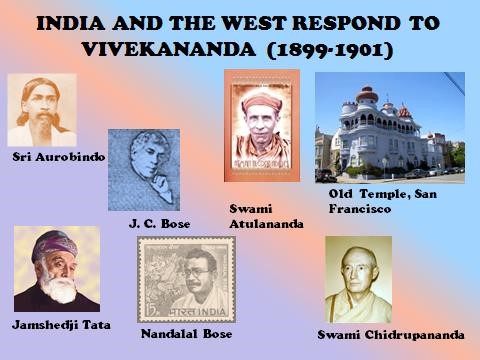
Furthermore, by what seems like a miracle, much of his epoch-making teachings, taken down by a young stenographer and stored in a trunk for fifty years came to light, providing us with the data of Vivekananda’s teachings of this time and thus rounding out and completing the picture of Vivekananda’s work in the West.
During this phase of his Indian work, Vivekananda went on pilgrimage, meeting the Indian people informally and propagating his message directly, while at the same time writing for his English and Bengali language periodicals, thereby getting a chance—for the first time—to systematize his thought on the work, and especially on Sri Ramakrishna. This was a major conclusion, a meeting of the devotion of the Indian people with the organized thought on Vedanta they so urgently needed. Some of those influenced by his work at this time included Sri Aurobindo, Jagadish Chandra Bose, Jamshedji Tata, and Nandalal Bose.
Summary
In all of the foregoing I have sought to show how the democratic vision of the innate divinity of humanity originated in the words of Sri Ramakrishna and were taken up and shared with both the West and India by Vivekananda, who gave the twist in each location that spoke best to the needs of the culture and the time at which he spoke. In addition, each succeeding step of spiritual humanism takes us deeper and deeper

into its meaning and implications for our lives, if we are ready to follow along and go there completely. In the hands of Vivekananda each of these steps resulted in highly significant responses from those who heard him and in permanent records and institutions that are still with us and influencing us to arise, awake and stop not till the goal of recognizing the divine value of all of our human kin and serving them with reverence and love is fully established as our norm. Should we doubt that we, too, are called to such work for the good of humanity? And, too, to find the points of communication between the two different ways Vivekananda presented the idea to the two dominant “sides” of the world—India and the West?
- Basu, Sankari Prasad. (1982). Letters of Sister Nivedita in 2 Vols. Calcutta: Nababharat, Vol. II: Ridgely Manor, 1899, p.1263.
- Nikhilananda, Swami (trans.), (2000). The Gospel of Sri Ramakrishna, February, 1882, p.84. Originally Recorded in Bengali by M., A Disciple of the Master. Mylapore, Chennai: Sri Ramakrishna Math (Hereafter Gospel).
- Vivekananda, Swami. Complete Works, Mayavati Memorial Edition. Calcutta: Advaita Ashrama, Vol.1: Paper on Hinduism, p.14 (Hereafter CW).
- CW, Vol.6: Notes Taken Down in Madras, 1892-93, p.115.
- Ibid., Sunday, February 18, 1883, p.181.
- CW, Vol.1: The Hindu Religion, p.330.
- CW, Vol.4: Reply to the Madras Address, pp.350-351.
- CW, Vol.6: Letter to Swami Ramakrishnananda from the USA, 1895, p.335.
- Gospel, Sunday, September 14th, 1884, p.525.
- CW, Vol.1: The Vedanta Philosophy, p.364.
- CW, Vol.3: The Vedanta in All Its Phases, p.347.
- CW, Vol.2: Practical Vedanta I, p.297.
- CW, Vol.3: The Vedanta, pp.409-410.
- CW, Vol.6: Letter to Swami Ramakrishnananda from Chicago, 1894, p.283.
- CW, Vol. 8: Is Vedanta the Future Religion? pp.125-126.
- CW, Vol. 8 :My Life and Mission, pp. 78-79.
- CW, Vol.5: Letter to Mary Hale from New York, February 1, 1895, p.72. 18 CW, Vol.6: Hinduism and Shri Ramakrishna, p.181.
Presented September 11, 2015, ISOL Conference, Art Institute of Chicago.